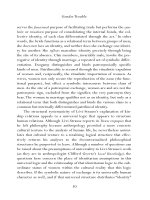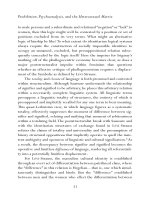GENDER TROUBLE 120
Bạn đang xem bản rút gọn của tài liệu. Xem và tải ngay bản đầy đủ của tài liệu tại đây (20.47 KB, 1 trang )
Prohibition, Psychoanalysis, and the Heterosexual Matrix
and lesbian cultures. As a very partial effort to come to terms with that
maternalist discourse, however, Julia Kristeva’s description of the
semiotic as a maternal subversion of the Symbolic will be examined in
the following chapter.
What critical strategies and sources of subversion appear as the
consequence of the psychoanalytic accounts considered so far? The
recourse to the unconscious as a source of subversion makes sense, it
seems, only if the paternal law is understood as a rigid and universal
determinism which makes of “identity” a fixed and phantasmatic affair.
Even if we accept the phantasmatic content of identity, there is no reason to assume that the law which fixes the terms of that fantasy is
impervious to historical variability and possibility.
As opposed to the founding Law of the Symbolic that fixes identity
in advance, we might reconsider the history of constitutive identifications without the presupposition of a fixed and founding Law. Although
the “universality” of the paternal law may be contested within anthropological circles, it seems important to consider that the meaning that the
law sustains in any given historical context is less univocal and less
deterministically efficacious than the Lacanian account appears to
acknowledge. It should be possible to offer a schematic of the ways in
which a constellation of identifications conforms or fails to conform to
culturally imposed standards of gender integrity.The constitutive identifications of an autobiographical narrative are always partially fabricated in the telling. Lacan claims that we can never tell the story of our
origins, precisely because language bars the speaking subject from the
repressed libidinal origins of its speech; however, the foundational
moment in which the paternal law institutes the subject seems to function as a metahistory which we not only can but ought to tell, even
though the founding moments of the subject, the institution of the law,
is as equally prior to the speaking subject as the unconscious itself.
The alternative perspective on identification that emerges from
psychoanalytic theory suggests that multiple and coexisting identifications produce conflicts, convergences, and innovative dissonances
85









